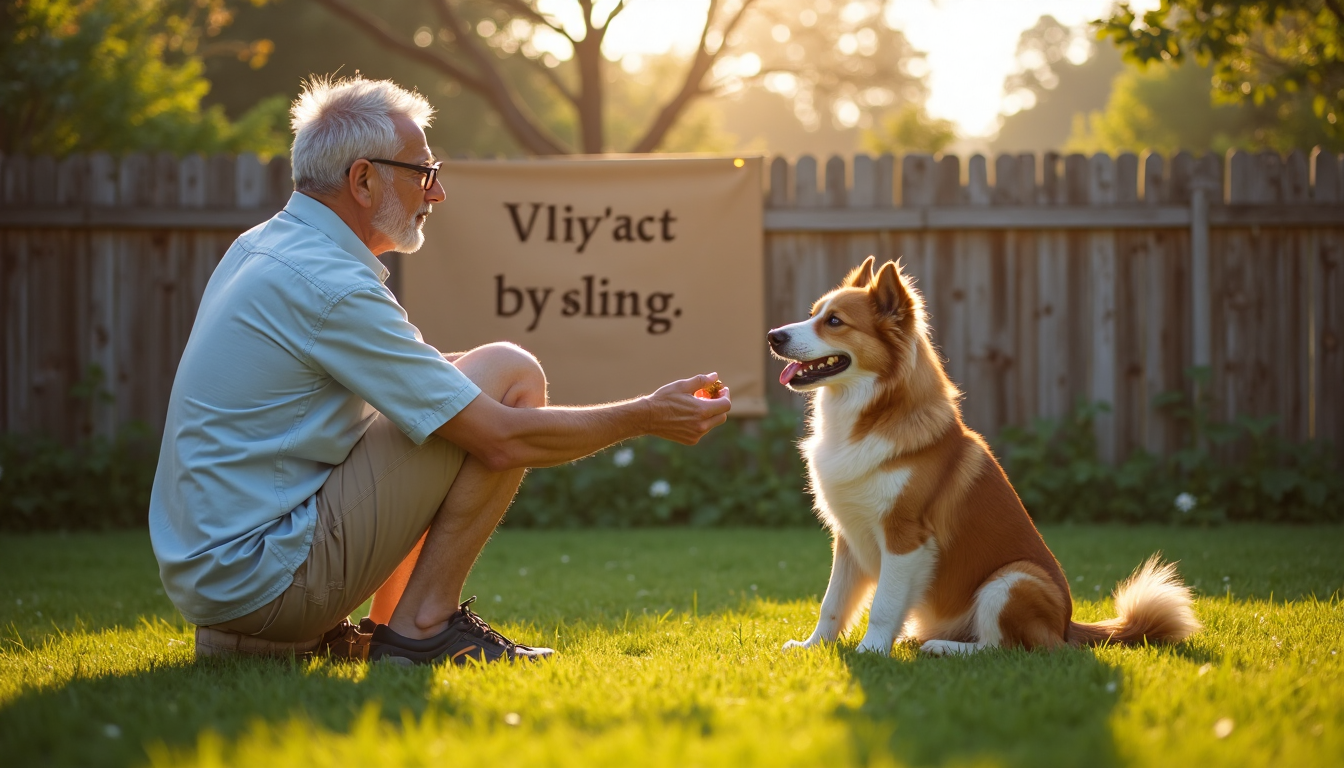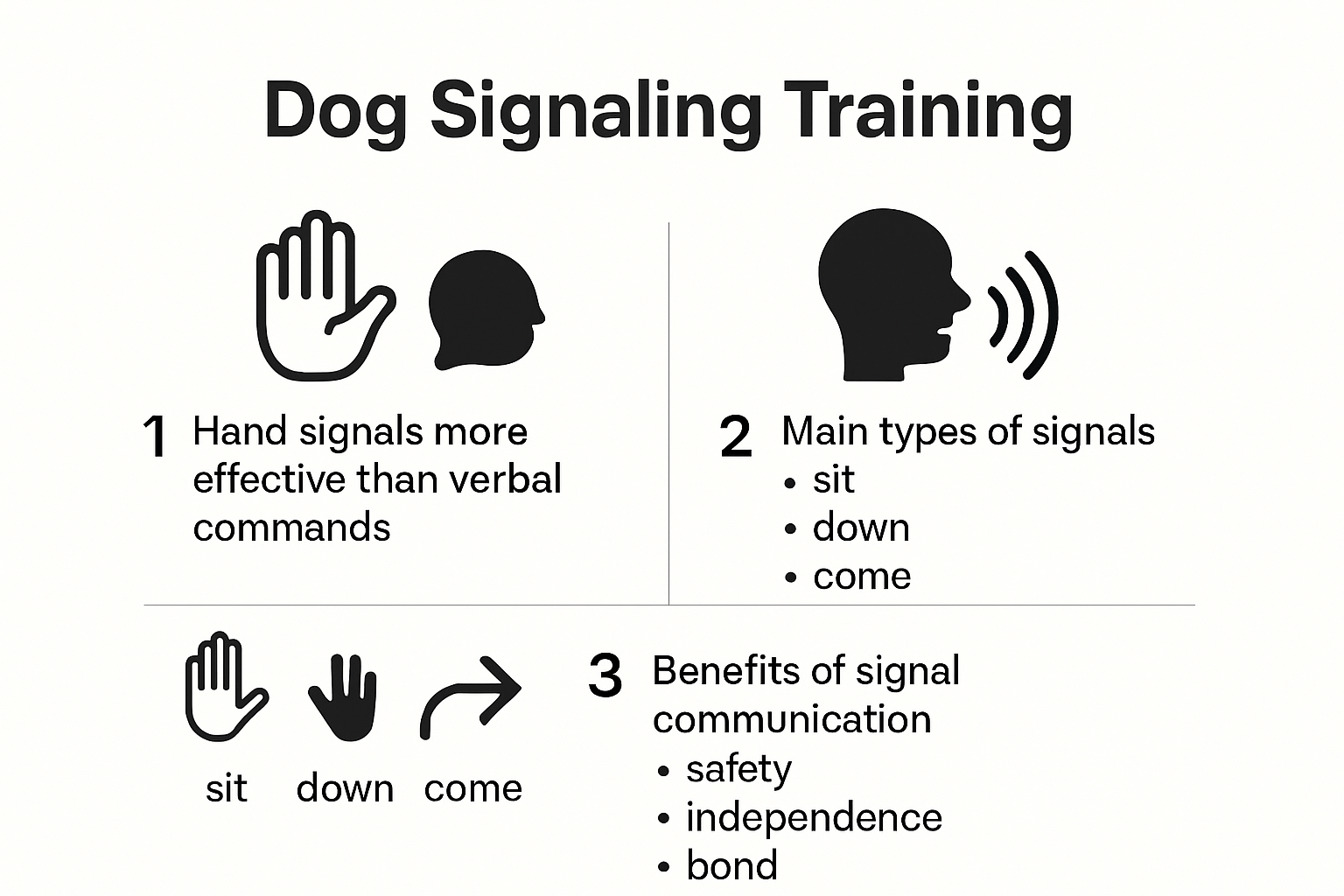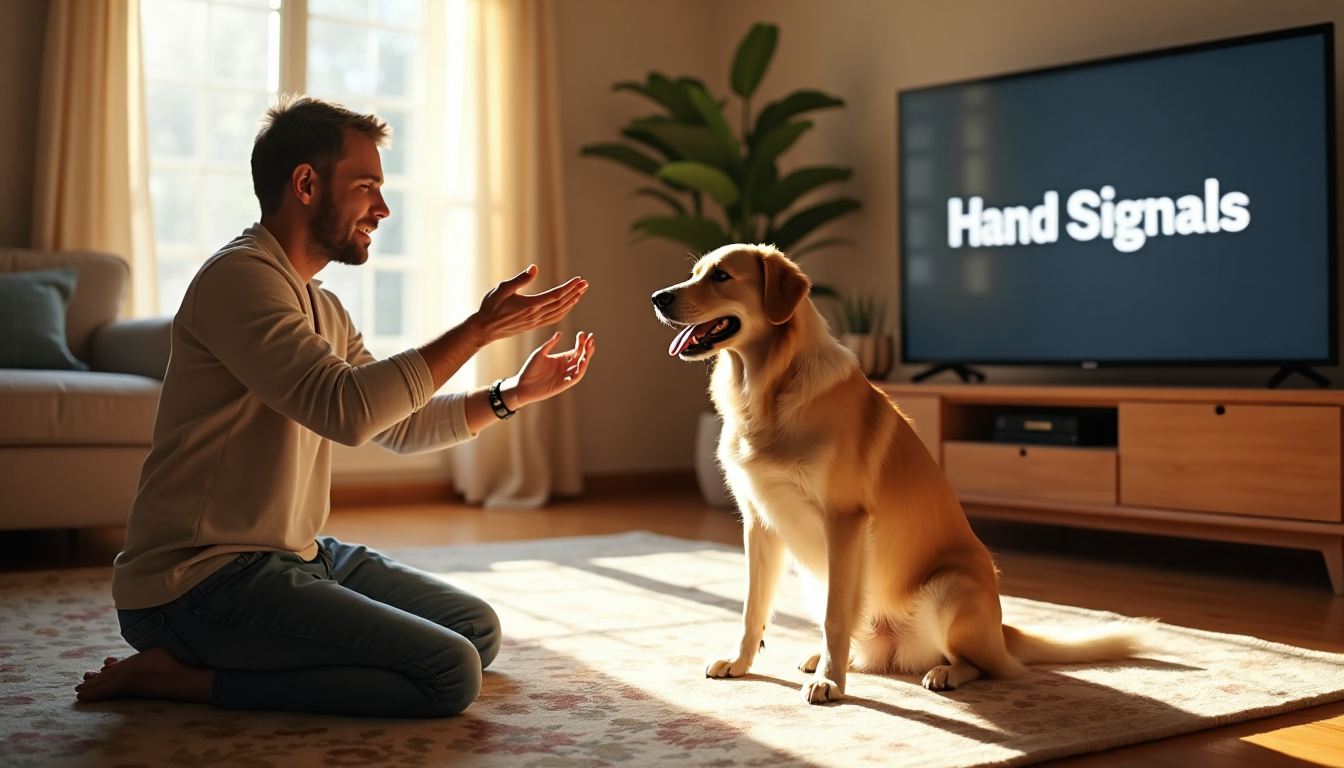
Teaching your dog hand signals might sound like a simple trick, but there is a lot more science behind it than most people realize. Here is the jaw-dropper. Dogs respond to hand signals with a staggering 99 percent accuracy compared to just 82 percent for verbal commands. Surprised? Most owners spend years shouting commands and get frustrated, not knowing that their dog could learn three times faster just by reading their hands. The real breakthrough lies in building a unique language with your dog—one rooted in trust, clarity, and even emotional connection.
Table of Contents
- Why Dog Signaling Training Matters
- Essential Commands And Hand Signals
- Step-By-Step Training Techniques
- Tips For Different Dog Owners And Needs
Quick Summary
| Takeaway | Explanation |
|---|---|
| Importance of Dog Signaling Training | Dog signaling training enhances communication between humans and dogs, fostering safety, independence, and a deeper connection beyond basic obedience. |
| Mastering Hand Signals | Dogs respond up to three times faster to visual cues compared to verbal commands, making the development of clear hand signals essential for effective training. |
| Personalized Training Approaches | Tailoring training techniques to match each dog’s age, background, and individual needs is crucial for successful communication and learning. |
| Psychological Benefits | Signal training strengthens the emotional bond between dogs and owners, boosting both parties’ confidence and engagement in the communication process. |
| Adaptable Training Techniques | Different dog owners should customize their approach based on their own capabilities and their dog’s specific characteristics for optimal training outcomes. |
Why Dog Signaling Training Matters
Dog signaling training represents a critical communication bridge between humans and their canine companions, transforming how we understand and interact with our four legged friends. This approach goes far beyond basic obedience, creating a nuanced language that supports safety, independence, and deeper connection.
The Science of Canine Communication
Understanding dog signaling is rooted in complex behavioral science. Research published in Animal Cognition revealed that dogs employ 19 distinct referential signals to communicate their needs. These signals range from requesting food to seeking attention or indicating potential dangers. The American Kennel Club found that dogs respond to visual cues with remarkable accuracy, with hand signals generating a 99% correct response rate compared to 82% for verbal commands.
This scientific insight underscores why training dogs in signaling is more than a novelty. It represents a fundamental approach to understanding canine cognitive capabilities and enhancing human animal interactions. For service dogs, rescue animals, and pets living with individuals with disabilities, these communication skills become even more critical.

Safety and Independence Through Signaling
Signal training provides crucial benefits for both dogs and their handlers. Our comprehensive guide on dog alert signals demonstrates how structured communication can prevent potential dangerous situations. For individuals with hearing or mobility challenges, a well trained dog capable of clear signaling can be a lifeline.
A significant study involving 142 dogs demonstrated that structured training significantly improves obedience and positive social interactions. Dogs trained in signaling exhibit higher responsiveness, reduced anxiety, and improved ability to communicate complex needs. This training methodology transforms dogs from passive companions to active communication partners.
Psychological and Emotional Benefits
Beyond practical applications, dog signaling training offers profound psychological advantages. The process of learning signals creates a deeper emotional bond between dogs and their humans. It requires patience, mutual understanding, and consistent practice. Dogs feel more secure when they can effectively communicate their needs, while humans gain confidence in their ability to understand and support their animal companions.
The training process itself becomes a form of mental stimulation for dogs, engaging their cognitive abilities and providing structured learning opportunities. For rescue dogs or those with previous traumatic experiences, signal training can be particularly transformative, helping them rebuild trust and feel more integrated into their new environments.
Effective dog signaling is not just about teaching commands. It is about creating a shared language of trust, safety, and mutual respect. As we move into 2025, the importance of understanding and implementing comprehensive communication strategies with our canine companions becomes increasingly clear. By investing time in signal training, dog owners can unlock a world of deeper connection, enhanced safety, and mutual understanding.
Essential Commands and Hand Signals
Mastering dog signaling requires a systematic approach to teaching essential commands through precise hand signals. This foundational communication method transforms how dogs and humans interact, creating a clear and reliable language of understanding.
Basic Foundational Hand Signals
Research from Nihon University demonstrates that dogs respond up to three times faster to visual cues compared to verbal commands. This scientific insight underscores the importance of developing a comprehensive hand signal training strategy. Learn more about advanced signal techniques to enhance your training approach.
The core hand signals every dog owner should master include:
-
Sit Signal: Extend your hand palm up, then move it upward from your side to shoulder height. This vertical motion naturally encourages the dog to lower its hindquarters.
-
Stay Signal: Hold your open palm directly in front of the dog at chest height, creating a clear stop motion. This universal signal communicates immediate pause and restraint.
-
Come Signal: Sweep your arm from your side toward your body in a broad, welcoming arc. This motion creates a visual invitation that dogs instinctively understand.
Below is a table summarizing the key hand signals and their descriptions for quick reference:
| Command | Hand Signal Description |
|---|---|
| Sit | Extend hand palm up, move upward from side to shoulder height |
| Stay | Hold open palm in front of dog at chest height (stop motion) |
| Come | Sweep arm from side toward your body in a broad, welcoming arc |
| Directional Guidance | Use pointed fingers to indicate specific movement directions |
| Emotional State | Recognize and respond to dog’s current emotional or physical needs (advanced cues) |
| Alert Signal | Teach dog to communicate potential dangers or environmental changes (alerting gesture) |
Advanced Signaling Techniques
Beyond basic commands, advanced signaling involves nuanced communication that addresses specific needs. According to Purina training experts, successful hand signal training requires consistent practice and positive reinforcement. Dogs learn best through repetition and clear, consistent visual cues.

Advanced signals can include more complex instructions such as:
- Directional Guidance: Using pointed fingers to indicate specific movement directions
- Emotional State Signals: Recognizing and responding to signals that communicate a dog’s current emotional or physical needs
- Alert Signals: Teaching dogs to communicate potential dangers or specific environmental changes
Training Methodology and Precision
Effective hand signal training follows a structured approach. Start with simple, distinct movements that are easily distinguishable from one another. Use high value treats as immediate rewards to reinforce correct responses. Consistency is key no matter the dog’s age or previous training background.
Practice signals in various environments to ensure the dog understands the command across different contexts. Begin training in quiet, low distraction spaces and gradually introduce more complex scenarios. This methodical approach helps dogs generalize their understanding of hand signals.
Remember that every dog learns differently. Some may pick up hand signals quickly, while others require more patient and repetitive training. Observe your dog’s individual learning style and adjust your approach accordingly. The goal is not just obedience, but creating a robust communication system that strengthens the bond between you and your canine companion.
As we move into 2025, dog signaling represents more than just a training technique. It is a sophisticated method of interspecies communication that promotes understanding, safety, and mutual respect. By investing time in developing these skills, dog owners can unlock a deeper level of connection with their pets.
Step-by-Step Training Techniques
Successful dog signaling training requires a structured, patient approach that combines scientific understanding with practical techniques. By breaking down the training process into manageable steps, dog owners can create a robust communication system with their canine companions.
Foundational Training Principles
Research in Animal Cognition reveals that dogs most effectively learn when verbal and non-verbal signals are integrated. This means combining hand signals with consistent vocal cues creates a more comprehensive learning environment. Our comprehensive training guide provides additional insights into developing effective communication strategies.
Key foundational principles include:
- Consistency: Use identical hand signals and verbal commands each time
- Positive Reinforcement: Reward correct responses immediately
- Short Training Sessions: Limit practice to 10-15 minute intervals
- Gradual Complexity: Start with simple signals and progressively increase difficulty
Below is a process table outlining the recommended progression for dog signaling training sessions:
| Step | Description |
|---|---|
| 1. Consistency | Use identical hand signals and verbal cues every time |
| 2. Positive Reinforcement | Immediately reward correct responses with treats or praise |
| 3. Short Sessions | Limit individual training sessions to 10–15 minutes |
| 4. Increase Complexity | Gradually introduce more complex signals after basics are mastered |
| 5. Diversify Contexts | Practice signals in new locations and with more distractions |
| 6. Adapt Techniques | Observe your dog and adjust methods to their learning pace |
Advanced Training Techniques
A study published in Frontiers in Veterinary Science demonstrated the effectiveness of clicker training in enhancing dog learning. This technique involves using a distinct clicking sound to mark precisely when a dog performs the correct action, followed immediately by a reward. The clicker serves as a precise communication tool that bridges the moment of correct behavior and the subsequent reward.
Advanced training techniques include:
- Marker Training: Using verbal markers or clickers to indicate correct behaviors
- Shaping: Breaking complex signals into smaller, achievable steps
- Chaining: Combining multiple signals into cohesive sequences
Personalized Training Approach
Research from Animals journal emphasizes the importance of understanding individual dog learning styles. Each dog processes information differently, requiring trainers to adapt their techniques to the specific dog’s personality, breed characteristics, and previous experiences.
Key steps for personalized training include:
- Assess your dog’s baseline understanding and learning pace
- Identify motivational rewards specific to your dog
- Create a calm, distraction free training environment
- Practice signals in multiple contexts and environments
- Monitor and adjust training techniques based on dog’s progress
Successful dog signaling training is not about perfection but about building a communication bridge. Patience, consistency, and understanding are the most critical tools in your training toolkit. Dogs are intelligent creatures capable of remarkable learning when approached with respect and systematic methodology.
As we move into 2025, dog training continues to evolve, emphasizing communication over mere obedience. By investing time in understanding and implementing these step-by-step techniques, dog owners can transform their relationship with their pets, creating a deeper, more meaningful connection based on mutual understanding and trust.
Tips for Different Dog Owners and Needs
Dog signaling training is not a one-size-fits-all approach. Different dog owners and their unique circumstances require tailored strategies that address specific needs, challenges, and goals. Understanding these variations helps create more effective communication and training experiences.
Training for Different Life Stages
According to veterinary behavioral experts, consistency is the cornerstone of successful dog training. However, the approach must adapt to the dog’s age, background, and individual characteristics. Our comprehensive training guide offers insights into customizing training techniques.
Training considerations for different life stages include:
- Puppies: Focus on foundational signals, short training sessions, and high-energy positive reinforcement
- Adult Dogs: Emphasize refinement of existing skills, introducing more complex signals
- Senior Dogs: Adapt training to physical limitations, use gentler techniques, shorter sessions
Below is a summary table outlining training modifications for different life stages of dogs:
| Life Stage | Training Focus | Modifications |
|---|---|---|
| Puppies | Foundation signals, short sessions, high-energy rewards | Keep sessions fun and brief |
| Adult Dogs | Skill refinement, introduce complex signals | Increase challenge and duration |
| Senior Dogs | Maintain learned skills, adapt to limitations | Use gentle cues, keep sessions very short |
Specialized Training for Unique Needs
Research from the American Kennel Club highlights that different dog types require specialized signaling approaches. Service dogs, rescue dogs, and dogs with specific physical or behavioral challenges need targeted training strategies.
Specialized training approaches include:
- Service Dogs: Precise, task-specific signaling for mobility assistance, medical alert, and emotional support
- Rescue Dogs: Trauma-informed training focusing on building trust and communication
- Dogs with Disabilities: Adaptive signaling techniques that accommodate physical or sensory limitations
- Working Dogs: Complex signal chains for professional tasks like search and rescue, detection work
Owner-Specific Training Adaptations
The Collar Club Academy emphasizes that owner characteristics significantly impact training success. Factors such as physical ability, time availability, and prior dog training experience play crucial roles in developing effective signaling techniques.
Considerations for different owner profiles:
- First-Time Dog Owners: Start with basic signals, seek professional guidance, attend training classes
- Experienced Handlers: Focus on advanced signaling, refine existing communication techniques
- Owners with Limited Mobility: Develop low-movement signals, use assistive training technologies
- Busy Professionals: Implement efficient, time-conscious training methods
Successful dog signaling training transcends generic instructions. It requires a nuanced understanding of both the dog’s unique characteristics and the owner’s specific context. By recognizing and adapting to these individual differences, owners can create a robust, personalized communication system.
As we move into 2025, dog training continues to evolve, emphasizing individualized approaches that respect the diverse needs of dogs and their human companions. The key is flexibility, patience, and a commitment to understanding the unique language of communication between species.
Frequently Asked Questions
What are the benefits of using hand signals for dog training?
Using hand signals for dog training enhances communication between dogs and their owners, leading to improved obedience and engagement. Dogs respond more accurately to visual cues, resulting in up to 99% accuracy compared to 82% for verbal commands.
How can I start training my dog with hand signals?
Begin by introducing basic hand signals like ‘sit,’ ‘stay,’ and ‘come.’ Use clear, consistent movements and reward your dog immediately for correct responses. Short training sessions of 10-15 minutes are effective for maintaining focus.
What should I do if my dog doesn’t respond to hand signals?
If your dog doesn’t respond, ensure that you are using distinct and clear signals. Additionally, practice in a distraction-free environment and gradually introduce the signals in different locations. Be patient and adjust your training techniques to suit your dog’s learning pace.
Can I train an older dog to respond to hand signals?
Yes, older dogs can learn to respond to hand signals. Tailor your training approach to their physical ability and cognitive function. Use gentle techniques, short sessions, and reinforce learned behaviors with positive rewards.
Unlock Clearer Communication and Real Safety for Your Dog
Are you frustrated when your dog misses your hand signals, especially in moments when communication is crucial? As the article “How to Train Dog Signaling: Simple Steps for 2025” explains, improving the language between you and your canine partner is essential for both safety and independence. Many owners struggle when they need a reliable alert in sudden situations or when their dog lives with someone who has hearing or mobility challenges. If you want your dog to signal their needs with clarity and confidence every time, ipuppee.com can bridge the gap between hand signal training and real-world security.

Take action now by discovering the innovative iPupPee device that lets your dog alert you with a simple press of a button. Our solutions empower dog owners with easy training resources, customer stories, and tools designed for everyone from service dog handlers to new puppy families. Do not let a missed signal become a missed opportunity for safety. Visit ipuppee.com today and explore how you can strengthen your dog’s voice while building trust and peace of mind.
Recommended
-
https://ipuppee.com/blogs/news/dog-signal-training-guide-2025)
-
https://ipuppee.com/blogs/news/dog-alert-signals-recognize-respond-2025)
-
https://ipuppee.com/blogs/news/how-to-teach-dogs-basic-commands)
-
https://ipuppee.com/blogs/news/dog-response-training-guide-owners-handlers-2025)
-
https://ipuppee.com/blogs/news/training-techniques-for-dogs-guide-owners-handlers-2025)

